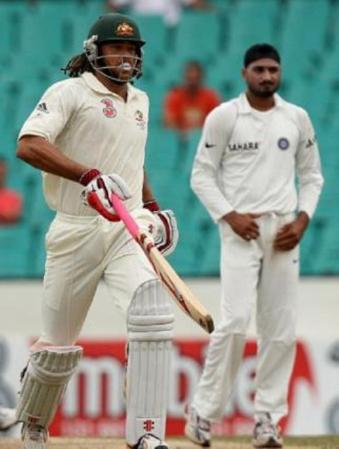
Where there's India versus Australia, there's controversy
Actions are a real measure of intelligence and, by flipping their fingers Kohli and Sharma have shown what they lack.
Every time team India travels to Australia, the heat down under takes a hard toll on them, be it the 2007-08 infamous ‘monkey-gate’ episode or the 2011-12 Virat Kohli episode, when he showed the crowd his middle finger. Controversies are sure to hover over the Indian cricket team when they play down under.
The ‘monkey-gate’ embroilment, during the Sydney Test, gained a lot of momentum, where Harbhajan Singh was charged for racially abusing Australia’s Andrew Symonds as a black monkey while Harbhajan refuted by saying he was just using ‘teri maa ki’ – which is an Indian slang phrase. Later, Matthew Hayden termed Harbhajan as an “obnoxious little weed” on a live radio interview.
 Andrew Symonds (L) and Harbhajan Singh while playing the Sydney Test match in January, 2008. Photo: AFP
Andrew Symonds (L) and Harbhajan Singh while playing the Sydney Test match in January, 2008. Photo: AFPIn 2011-12, team India travelled to Australia for a long, enervating tour. Losing the first Test, the team vowed to make amends in Sydney but the atrocious Sydney came to haunt them once again. After failing with the bat in the first innings, the Michael Clarke-tide swept away the Indians, causing some verbal jibes from the fans to which Virat Kohli replied with his middle finger.
Later, he clarified on Twitter that it was a payback gesture to unruly fans. Kohli was fined 50% of his match fee.
In the next Test at Perth, Indian pacer Ishant Sharma couldn’t control his hands. He also reacted to the taunts of some enraged fans by showing them the middle finger. While Virat did it on the ground, in front of television cameras and a million eyes, Ishant too could not take the fans’ tongue wagging and greeted them with his finger after the match.
 Ishant Sharma (L) and Virat Kohli
Ishant Sharma (L) and Virat KohliHark back your mind to 2005, when Greg Chappell was also involved in a similar finger-gate hurrah. The Indian crowd did not accept it and now the tag has been carried to Australia.
Kohli’s argument was that the fans abused his family. Ishant might tow a similar line but what they are forgetting is that some battles are best not fought. It is more of an immatureness that is being displayed by these sports ambassador of the country. Kohli and Sharma wanted to be like Bollywood actors, punishing guilty fans by themselves.
It might be just a finger gesture for them but actions speak louder than words. It landed them in hot water. Actions are a real measure of intelligence and, by flipping their fingers Kohli and Sharma have shown what they lack.
The young brigade is defined by youthful rebellion, with spiked, gelled hair, and tattooed arms. Their attitude is fine, perhaps aggressive too, but them losing their calm so easily is worrying. What such actions highlight is how flappable young Indian cricketers are. They have learnt the art of playing from their seniors but what they didn’t learn is the temperament and manners of the senior players. Look at Sachin Tendulkar, Rahul Dravid and VVS Laxman, who have always conducted themselves with the utmost poise and presence, wherever they have been.
 Sachin Tendulkar (L), Rahul Dravid (C) and V. V. S. Laxman (R)
Sachin Tendulkar (L), Rahul Dravid (C) and V. V. S. Laxman (R)Once again, team India has set its foot in Australia to play a long Test series, but it is unlikely that this time the build-up to the tour will be different. The tragic death of Australian cricketer, Phillip Hughes, has left the players and the nation in emotional apathy, however, this might prove to be more of a vulnerability during the series as emotions will rule the minds of the Aussies. Their captain, Michael Clarke, has already declared that he wants to win this one for his beloved Phillip Hughes, who was a brother to him.
So, expect plenty of drama, emotions and verbal jibes. It will be interesting to see how team India reacts to this approach, will they let it go by understanding the emotions of the grief stricken Aussies, or will they revert back with same force?
The battle of mind and emotions will be one to watch out for; the scorching summer in Australia has already begun and things will surely boil down under.




COMMENTS (42)
Comments are moderated and generally will be posted if they are on-topic and not abusive.
For more information, please see our Comments FAQ